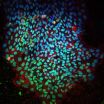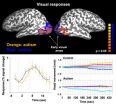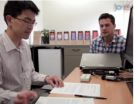(Press-News.org) LA JOLLA, CA---- Salk scientists have identified a unique molecular signature in induced pluripotent stem cells (iPSCs), "reprogrammed" cells that show great promise in regenerative medicine thanks to their ability to generate a range of body tissues.
In this week's Proceedings of the National Academy of Sciences, the Salk scientists and their collaborators at University of California, San Diego, report that there is a consistent, signature difference between embryonic and induced pluripotent stem cells. The findings could help overcome hurdles to using the induced stem cells in regenerative medicine.
"We believe that iPSCs hold a great potential for the treatment of human patients," says Juan Carlos Izpisua Belmonte, a professor in Salk's Gene Expression Laboratory and the senior author on the paper. "Yet we must thoroughly understand the molecular mechanisms governing their safety profile in order to be confident of their function in the human body. With the discovery of these small, yet apparent, epigenetic differences, we believe that we are now one step closer to that goal."
Embryonic stem cells (ESCs) are known for their "pluripotency," the ability to differentiate into nearly any cell in the body. Because of this ability, it has long been thought that ESCs would be ideal to customize for therapeutic uses. However, when ESCs mature into specific cell types, and are then transplanted into a patient, they may elicit immune responses, potentially causing the patient to reject the cells.
In 2006, scientists discovered how to revert mature cells, which had already differentiated into particular cell types, such as skin cells or hair cells, back into a pluripotent state. These "induced pluripotent stem cells" (iPSCs), which could be developed from the patient's own cells, would theoretically carry no risk of immune rejection.
However, scientists found that iPSCs had molecular differences from embryonic stem cells. Specifically, there were epigenetic changes, chemical modifications in DNA that might alter genetic activity. At certain points in the iPSC's genome, scientists could see the presence of different patterns of methyl groups when compared to the genomes of ESCs. It seemed these changes occurred randomly.
Izpisua Belmonte and his colleagues wanted to understand more about these differences. Were they truly random, or was there a discernable pattern?
Unlike previous studies, which had primarily analyzed iPSCs derived from only one mature type of cells (mainly connective tissue cells called fibroblasts), the Salk and UCSD researchers examined iPSCs derived from six different mature cell types to see if there were any commonalities. They discovered that while there were hundreds of unpredictable changes, there were some that remained consistent across the cell types: the same nine genes were associated with these common changes in all iPSCs.
"We knew there were differences between iPSCs and ESCs," says Sergio Ruiz, first author of the paper, "We now have an identifying mark for what they are."
The therapeutic significance of these nine genes awaits further research. The importance of the current study is that it gives stem cells researchers a new and more precise understanding of iPSCs.
INFORMATION:
Other researches on the study were: Dinh Diep (co-first author), Athurva Gore, Athanasia D. Panopoulos, Nuria Montserrat, Nongluk Plongthongkum, Sachin Kumar, Ho-Lim Fung, Alessandra Giorgetti, Josipa Bilic, Erika M. Batchelder, Holm Zaehres, Natalia G. Kan, Hans R. Schöler, Mark Mercola and Kun Zhang.
The work was supported by grants from the Instituto de Salud Carlos III, the Focht-Powell Fellowship, Fundacion Cellex, MINECO, Sanofi, the G. Harold and Leila Y. Mathers Charitable Foundation, The Leona M. and Harry B. Helmsley Charitable Trust, CIRM and NIH.
About the Salk Institute for Biological Studies:
The Salk Institute for Biological Studies is one of the world's preeminent basic research institutions, where internationally renowned faculty probe fundamental life science questions in a unique, collaborative, and creative environment. Focused both on discovery and on mentoring future generations of researchers, Salk scientists make groundbreaking contributions to our understanding of cancer, aging, Alzheimer's, diabetes and infectious diseases by studying neuroscience, genetics, cell and plant biology, and related disciplines.
Faculty achievements have been recognized with numerous honors, including Nobel Prizes and memberships in the National Academy of Sciences. Founded in 1960 by polio vaccine pioneer Jonas Salk, M.D., the Institute is an independent nonprofit organization and architectural landmark.
Discovery of reprogramming signature may help further stem cell-based regenerative medicine research
Salk scientists show nine genes at heart of epigenetic changes in induced pluripotent stem cells
2012-09-19
ELSE PRESS RELEASES FROM THIS DATE:
Sandia shows monitoring brain activity during study can help predict test performance
2012-09-19
ALBUQUERQUE, N.M. — Research at Sandia National Laboratories has shown that it's possible to predict how well people will remember information by monitoring their brain activity while they study.
A team under Laura Matzen of Sandia's cognitive systems group was the first to demonstrate predictions based on the results of monitoring test volunteers with electroencephalography (EEG) sensors.
For example, "if you had someone learning new material and you were recording the EEG, you might be able to tell them, 'You're going to forget this, you should study this again,' ...
Major changes needed to protect Australia's species and ecosystems
2012-09-19
A study has highlighted the sensitivity of Australia's species and ecosystems to climate change, and the need for new ways of thinking about biodiversity conservation.
'Climate change is likely to start to transform some of Australia's natural landscapes by 2030,' lead researcher, CSIRO's Dr Michael Dunlop said.
'By 2070, the ecological impacts are likely to be very significant and widespread. Many of the environments our plants and animals currently exist in will disappear from the continent. Our grandchildren are likely to experience landscapes that are very different ...
NYU neuroscientists find promise in addressing Fragile X afflictions
2012-09-19
Neuroscientists at New York University have devised a method that has reduced several afflictions associated with Fragile X syndrome (FXS) in laboratory mice. Their findings, which are reported in the journal Neuron, offer new possibilities for addressing FXS, the leading inherited cause of autism and intellectual disability.
Those afflicted with FXS do not possess the protein FMRP, which is a suppressor of protein synthesis. Absent this suppressor, protein synthesis is exaggerated, producing a range of mental and physical disorders.
Previous research has indirectly ...
Scientists show biological mechanism can trigger epileptic seizures
2012-09-19
CINCINNATI – Scientists have discovered the first direct evidence that a biological mechanism long suspected in epilepsy is capable of triggering the brain seizures – opening the door for studies to seek improved treatments or even preventative therapies.
Researchers at Cincinnati Children's Hospital Medical Center report Sept. 19 in Neuron that molecular disruptions in small neurons called granule cells – located in the dentate gyrus region of the brain – caused brain seizures in mice similar to those seen in human temporal lobe epilepsy.
The dentate gyrus is in the ...
Autism symptoms could arise from unreliable neural responses
2012-09-19
Diverse symptoms associated with autism could be explained by unreliable activity of neurons in the brain in response to basic, nonsocial sensory information, according to a study published by Cell Press on September 19th in the journal Neuron. The new findings suggest that autism is a disorder of general neural processing and could potentially provide an explanation for the origins of a range of psychiatric and neurological disorders.
"Within the autism research community, most researchers are looking for either a dysfunctional brain region or inadequate connections ...
Autistic adults have unreliable neural responses, Carnegie Mellon-led research team finds
2012-09-19
VIDEO:
New research led by Carnegie Mellon University neuroscientists takes the first step towards deciphering the connection between general brain function and the emergent behavioral patterns in autism. Published in...
Click here for more information.
PITTSBURGH— Autism is a disorder well known for its complex changes in behavior — including repeating actions over and over and having difficulty with social interactions and language. Current approaches to understanding ...
Neuroscientists investigate lotteries to study how the brain evaluates risk
2012-09-19
People are faced with thousands of choices every day, some inane and some risky. Scientists know that the areas of the brain that evaluate risk are the same for each person, but what makes the value assigned to risk different for individuals? To answer this question, a new video article in Journal of Visualized Experiments (JoVE) uses functional magnetic resonance imaging (fMRI) to characterize subjective risk assessment while subjects choose between different lotteries to play. The article, a joint effort from laboratories at Yale School of Medicine and New York University, ...
Nearly half of kidney recipients in live donor transplant chains are minorities
2012-09-19
The largest U.S. multicenter study of living kidney transplant donor chains showed that 46 percent of recipients are minorities, a finding that allays previous fears that these groups would be disadvantaged by expansion of the donor pool through this type of exchange process.
The study of a series of chain transplantations performed from February 2008 to June 2011 at 57 centers nationwide included 272 kidney transplants that paired organ donors who were incompatible with their relatives with strangers providing organs for altruistic reasons or with others donating an ...
Warming ocean could start big shift of Antarctic ice
2012-09-19
Fast-flowing and narrow glaciers have the potential to trigger massive changes in the Antarctic ice sheet and contribute to rapid ice-sheet decay and sea-level rise, a new study has found.
Research results published in the journal Proceedings of the National Academy of Sciences reveal in more detail than ever before how warming waters in the Southern Ocean are connected intimately with the movement of massive ice-sheets deep in the Antarctic interior.
"It has long been known that narrow glaciers on the edge of the Antarctica act as discrete arteries termed ice streams, ...
Did a 'forgotten' meteor have a deadly, icy double-punch?
2012-09-19
When a huge meteor collided with Earth about 2.5 million years ago and fell into the southern Pacific Ocean it not only could have generated a massive tsunami but also may have plunged the world into the Ice Ages, a new study suggests.
A team of Australian researchers says that because the Eltanin meteor – which was up to two kilometres across - crashed into deep water, most scientists have not adequately considered either its potential for immediate catastrophic impacts on coastlines around the Pacific rim or its capacity to destabilise the entire planet's climate system.
"This ...
LAST 30 PRESS RELEASES:
Global study reveals widespread burning of plastic for heating and cooking
MIT study shows pills that communicate from the stomach could improve medication adherence
Searching for the centromere: diversity in pathways key for cell division
Behind nature’s blueprints
Researchers search for why some people’s gut microbes produce high alcohol levels
Researchers find promising new way to boost the immune response to cancer
Coffee as a staining agent substitute in electron microscopy
Revealing the diversity of olfactory receptors in hagfish and its implications for early vertebrate evolution
Development of an ultrasonic sensor capable of cuffless, non-invasive blood pressure measurement
Longer treatment with medications for opioid use disorder is associated with greater probability of survival
Strategy over morality can help conservation campaigns reduce ivory demand, research shows
Rising temperatures reshape microbial carbon cycling during animal carcass decomposition in water
Achieving ultra-low-power explosive jumps via locust bio-hybrid muscle actuators
Plant-derived phenolic acids revive the power of tetracycline against drug-resistant bacteria
Cooperation: A costly affair in bacterial social behaviour?
Viruses in wastewater: Silent drivers of pollution removal and antibiotic resistance
Sub-iethal water disinfection may accelerate the spread of antibiotic resistance
Three in four new Australian moms struggle with body image
Post-stroke injection protects the brain in preclinical study
Cardiovascular risk score predicts multiple eye diseases
Health: estimated one in ten British adults used or interested in GLP-1 medications for weight loss
Exercise to treat depression yields similar results to therapy
Whooping cough vaccination for pregnant women strengthens babies’ immune system
Dramatic decline in new cases of orphanhood in Uganda driven by HIV treatment and prevention programs
Stopping weight loss drugs linked to weight regain and reversal of heart health markers
Higher intake of food preservatives linked to increased cancer risk
Mass General Brigham–developed cholera vaccine completes phase 1 trial
First experimental validation of a “150-year-old chemical common sense” direct visualization of the molecular structural changes in the ultrafast anthracene [4+4] photocycloaddition reaction
Lack of support for people on weight loss drugs leaves them vulnerable to nutritional deficiencies, say experts
Dogs’ dinners can have greater climate impact than owners’
[Press-News.org] Discovery of reprogramming signature may help further stem cell-based regenerative medicine researchSalk scientists show nine genes at heart of epigenetic changes in induced pluripotent stem cells




